Panasonic Lumix DMC-TZ20 Review
Panasonic Lumix DMC-TZ20
Panasonic ups the optical zoom ante with the 16x Lumix DMC-TZ20, which also features Full HD video, stereo sound, HDMI output, GPS and 3D modes.
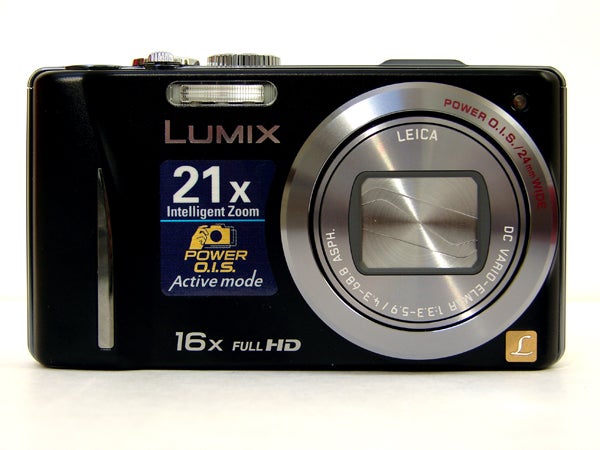
Verdict
Pros
- 16x zoom lens (24 - 384mm)
- inbuilt GPS
- 3D shooting mode
- Touch screen
- Good image quality
Cons
- Expensive
- Touchscreen can be fiddly
- Capture/Playback switch can get in the way
Key Specifications
- Review Price: £349.99
- 16x zoom lens (24 - 384mm)
- 14.2 megapixel sensor
- Touchscreen and physical controls
- Inbuilt GPS
- 3D shooting mode
If you’re restricted to just the one lens on a camera yet shoot a multitude of subjects, better make it a jack of all trades with as broad a focal range as possible. Now the question is, how to shoehorn that into a camera that will still fit in your pocket?
Panasonic thinks it has the answer in its Lumix DMC-TZ20 (also known as the DMC-ZS10 outside of Europe), which newly tops its ‘TZ’ range of so-called ‘travel zooms’. Previous models have seen its maker heralded as something of a trailblazer for slim(ish) bodied compacts with big zoom power, though in truth Ricoh has been quietly ploughing a similar furrow for a decade now. Nonetheless all three of this camera’s predecessors, the TZ10, TZ8 and TZ7 earned themselves recommended awards. 
Coming after the TZ10, and adopting a new 15.1 megapixel ‘Mos’ sensor said to better suppress noise, the 14.1 effective megapixel TZ20 sits just above the equally new TZ18 with which it shares many features. Optical zoom power has also been boosted to 16x, which is also accessible in movie mode, whilst pocket sized proportions are maintained by virtue of the lens being folded within the body when not in use. The reach can be further extended to 21x equivalent via the digital zoom, and, if you don’t mind resolution dropping to three megapixels, boosted to an equivalent 33.8x via Panasonic’s Extra Optical Zoom option. The lower resolution is because only the central part of the sensor is being used; in effect the camera is making a crop. So though it’s an impressive figure to stick on the box, there is a downside.
Whilst the headline 16x zoom sounds good in isolation, it’s worth bearing in mind that Fujifilm has had its 15x optical zoom FinePix F300EXR available since last year – to name just one stand-out competitor. The Fuji is both sleeker in design, being just 22.9mm at its ‘thickest’ point (to the Panasonic TZ20’s 33.4mm), and altogether sexier (thanks to a double gloss finish) if you are purely looking for the best compromise of big zoom in a small camera body. 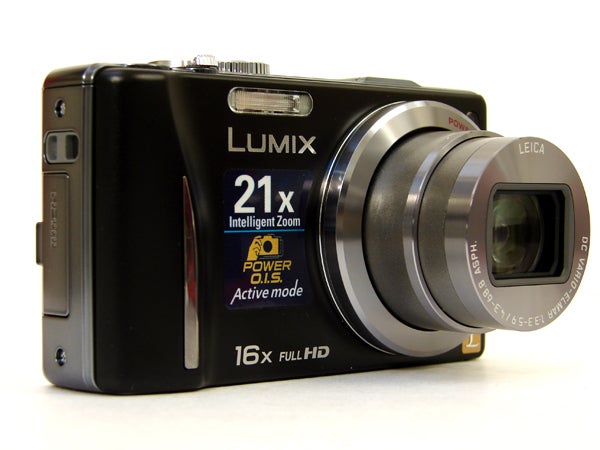
That said, the Panasonic has a couple of advantages over the Fuji, of which probably the most noteworthy is the TZ20’s built-in GPS antenna for storing longitude and latitude coordinates in the image file’s Exif data. Like the same feature on the ruggedised Lumix DMC-FT3, location info is provided for 203 countries and more than a million landmarks. The other draw over the Fuji is the TZ20’s Full HD video, against the F300EXR’s 1280×720 pixels clips. This comes with stereo sound via top-mounted microphones, not unheard of on a pocket compact but still fairly unusual, plus the choice of the highly compressed AVCHD or more widely compatible Motion JPEG video formats. HDMI output is also provided by a port hidden under a side flap for connecting it up directly to a flat panel TV.
As with the rest of the recent Lumix models, we also get a dedicated camcorder-like button for instant video recording. Although because flipping between capture mode and playback is controlled by a slider switch, you can’t ”instantly” record unless you happen to have the correct capture option physically selected at the time. The shooting mode wheel, meanwhile, houses program, shutter priority, aperture priority and manual modes, for when you want various degrees of manual control. You also get a user customisable setting, no less than three scene mode options plus, plus, for those who just want to point and shoot and let the camera reliably decide which parameters suit which scene or subject, there’s the most prominently marked mode here: intelligent Auto. The new mode on the dial that jumps out at you however is 3D mode; a new feature is shares with the equally new FT3 and FX77 snappers.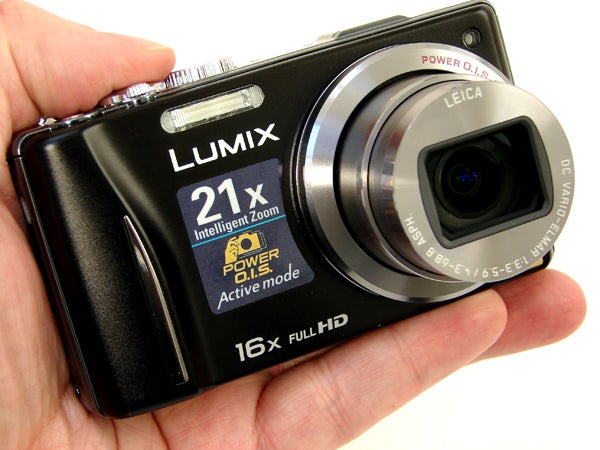
Like its two siblings, the TZ20 doesn’t actually feature twin lenses nor twin sensors, both featured on the Fujifilm Real 3D W3, to achieve its stereoscopic effect. Rather, in 3D mode the camera composites an image using a sequence of up to 20 individual frames. With 3D mode selected, the user simply presses the shutter release as normal and pans with the camera in the direction of the arrow provided on screen – easy enough for any beginner. This prompts a machine gun-like flurry of shot-taking, the camera automatically generating the end result and saving it as an MPO file. As with the 3D Panorama mode on rival Sony Cyber-shot cameras, this file isn’t actually viewable (yet) in all its glory unless you own a 3D TV, as the TZ20’s back screen remains resolutely two-dimensional.
Weighing a manageable 219g with rechargeable battery and optional (yet essential) SD card loaded, and slipping reasonably comfortably into the front pocket of a pair of jeans thanks to dimensions of 104.9 x 57.8 x 33.4mm the TZ20 is eminently portable, even if it’s not the absolute smallest. The matt black finish to our review model imbues it with a sense of sophistication and purpose. There’s the hint of a handgrip to the left hand side of the body (if viewed lens-on) and a tiny pad of nine raised nodules at the back to provide some purchase for the thumb, so you’ll generally want to use two hands for a secure and steady grip.
Changing settings is done via a combination of the 3-inch, 460k dot, touchscreen and physical buttons. Using the two in tandem can feel a little peculiar at first but in no time it becomes second nature. By touching the right hand side of the screen and swiping you finger up or down, you can even control the lens without otherwise nudging the lever encircling the shutter release button (though the physical control is less fiddly). 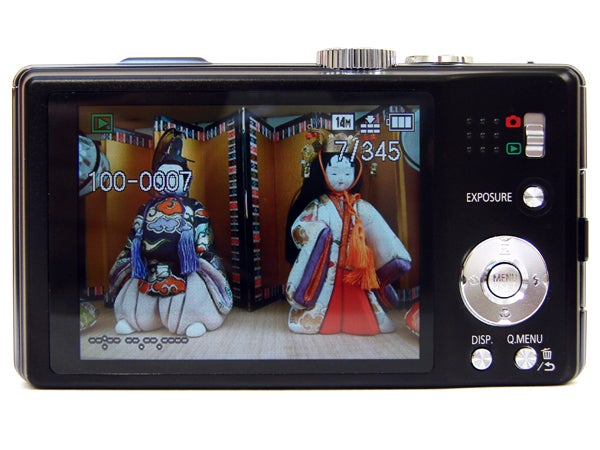
As with previous touch panel Panasonics, focus can be biased toward a particular subject simply by tapping it on screen, and the shutter can also be fired this way (though the latter can be deactivated to prevent accidentally taking a shot, which is otherwise fairly easy to do). Furthermore, when the camera’s in intelligent Auto (iA) mode and the subject is touched on screen, the camera selects the most relevant mode to best fit the subject; for example selecting portrait mode if the user touches a face, or landscape mode if it’s something more scenic. Screen brightness automatically adjusts through 11 stages depending on light conditions at the time so hopefully the best visibility is achieved without the user having to think about it. We were using the camera outside in bright sunlight and didn’t feel the usual urge to cup a hand around the screen to see what was going on.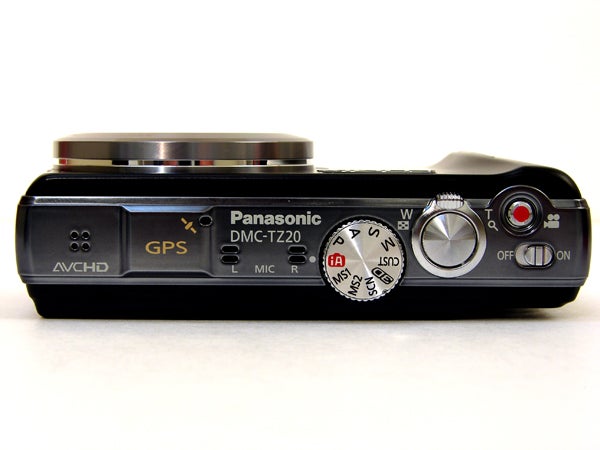
For squeezing those landscapes and group portraits into frame the TZ20’s Leica branded lens starts out at a wide angle 24mm equivalent in 35mm film terms, running up to 384mm at the telephoto end (to the Fuji’s 360mm). So, what you lose in sleekness is more than made up for in the quickness and convenience of not having to take steps forward and back to fit everything you want into frame. It’s optically image stabilised too, to avoid the blurring effects of camera shake, which are more pronounced when taking pictures at the telephoto end of the zoom or in lower light. Whilst not 100% perfect, more often than not we achieved results we were pleased with. Its maker has coupled this with an Active mode to boost the effect of the stabiliser when not only the photographer but the subject is on the move.
In terms of operation speed, you can achieve up to an impressive 10 frames per second in consecutive shooting mode, or 5fps if you have continuous AF selected. If you don’t mind a resolution drop to 3.5 megapixels then up to 60fps is also offered. Even in regular single shot mode the TZ20 remains a speed demon. The camera’s auto focus is also fast – a whopping 49% faster than its predecessor, says Panasonic, something that seemed to be borne out in testing. 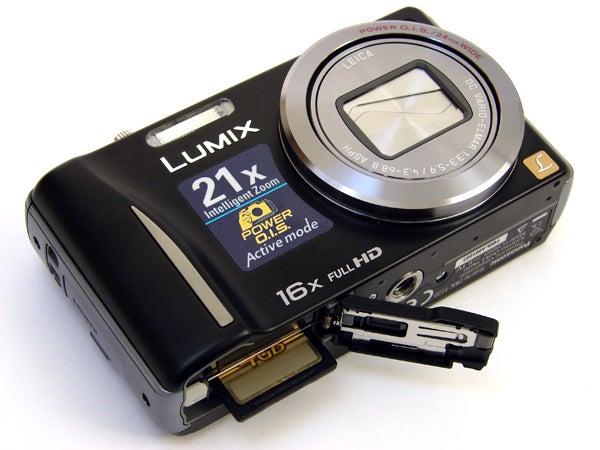
All of this inevitably costs though, and currently the TZ20 has a street price of £350, so you’re paying an inevitable premium for the camera’s combo of big lens, pocket-size chassis, and a payload of the latest must have features to round off the package. To put the Panasonic into context as regards rivals, this is not only dearer than the Fuji F300EXR, if only by £30 or so, but makes Canon’s own big zoom compact in the 12x optical PowerShot SX130 IS look an outright bargain at £150. If you don’t mind a slightly broader chassis still, Fuji also has the DSLR-styled 18x zoom S2800HD at the same price as the Canon, which is excellent value. None of them offer built-in GPS or 3D modes however. Have a look also at Casio’s £330 Exilim EX-H20G if you want GPS and a larger than average zoom, even if 10x seems modest compared to what’s on offer here.
Touch screen operation aside, in terms of handling the TZ20 is fairly conventional. The camera is activated with a flick of the on/off slider on the top plate, whereupon it will take just over two seconds to start up.
Nudge the physical zoom lever encircling the shutter release and the lens, which automatically starts off at its widest setting, glides through its basic 16x range in four seconds. OK, so this could be quicker and it’s also sound tracked by a low mechanical buzz, but at least its slow(ish) and steady progress allows you to generally arrive at the framing you want without having to go back and forth like you might have to on a speedier model. Fire the shutter when you’ve arrived at the composition you desire and any shutter lag is imperceptible, with a highest resolution JPEG committed to memory in around two seconds. All of this is pretty much the performance you’d expect from a point and shoot compact.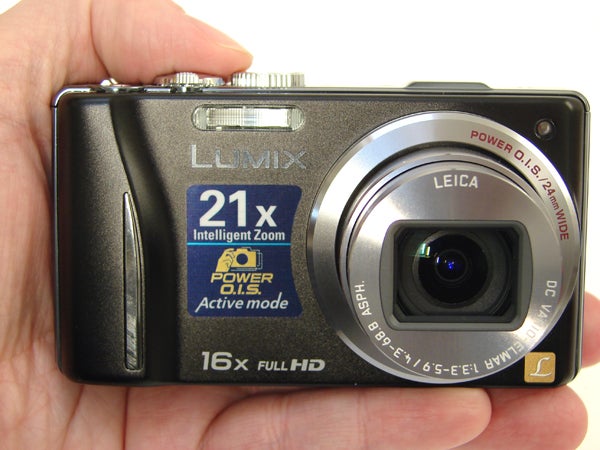
If we’ve one grumble it’s that we’d have liked to see capture mode as the camera’s automatic default setting and playback given a separate dedicated button. This way, if a new shot did suddenly present itself whilst you are reviewing the previous captured image, a half press of the shutter release button would throw you back into capture mode, as on Panasonic’s own FT3 model. As it is on the TZ20, you have to flick the switch from playback to capture, wait a brief moment for the camera to register the fact that you’ve changed settings, and then half press the shutter release button. Precious seconds wasted that can mean you’ve missed the shot you just saw. 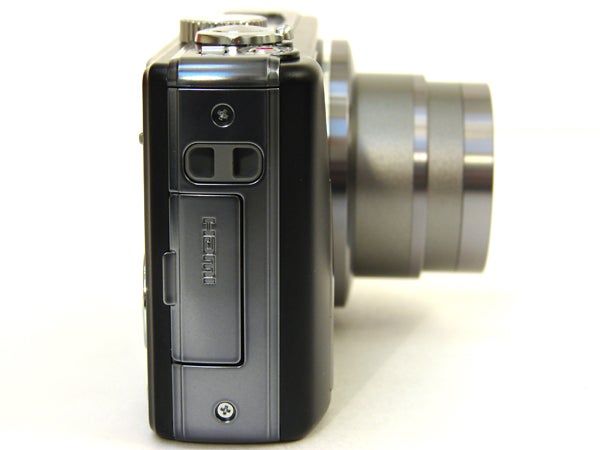
At the end of the day, image quality is the deciding factor and here too is pretty much what we expected, with a reliably consistent output from shot to shot. Colours move between natural and warm depending on which settings you have selected – and whether you’re allowing the camera to choose for itself, which generally favours the warmer option. Exposures are also even, metering mostly spot on, and detail is maintained from edge to edge of frame, even at maximum wideangle. Familiar bugbears such as pixel fringing and occasional loss of highlight detail rear their heads, but as we say these are par for the course for such a compact.
Its low light performance, whilst adequate, is nothing much to write home about, with the ISO range topping out at a modest manually selectable ISO1600, so it doesn’t feel like its maker is trying to push the envelope in this regard either. For really low light there’s the option to switch to the High Sensitivity option amidst the scene modes, but the result is a smoothing of detail that may make you wish you hadn’t bothered. Check out our ISO test examples to see for yourself.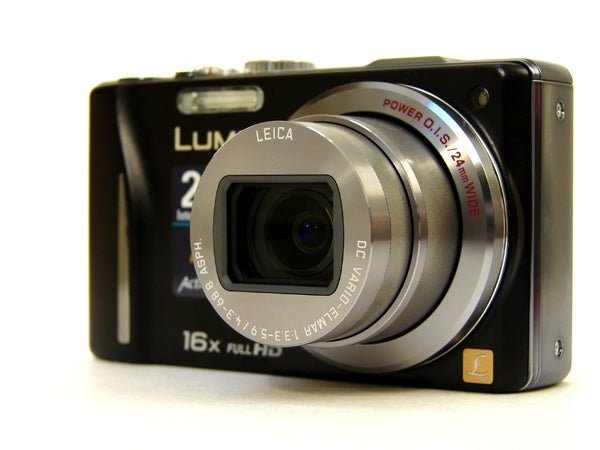
Ultimately the TZ20 is all about compositional versatility, and since results from the camera require little or no adjustment in Photoshop for the most part, it will best suit the family user who just wants to point and shoot in the most part, but would appreciate the flexibility of a longer lens to catch up with the kids running around.
”’Verdict”’
In offering up another dual operation Lumix – touch screen and/or physical controls – Panasonic is providing a ‘best of both worlds’ option that is actually simpler to use than you might imagine after an initial play. Not all of us might need the full extent of the zoom being offered here, but after you’ve used a broader than average focal range, going back to a compact with a 3x, 4x or even 7x zoom option feels a bit like trying to take pictures with one hand tied behind your back. Coming across as slightly more gimmicky are the functions that at first appear to be bulking up the specification list but you may well not be using everyday, such as the built-in GPS and 3D modes. But then again with both increasingly becoming must-haves on manufacturers’ spec lists, they help make the camera as ‘future proof’ as possible.
So perhaps the major nettle to grasp here is the TZ20’s cost, with a high-ish street price of around £350 on launch making it just £50 or so cheaper than a starter digital SLR with kit lens. Moreover, you can pick up other very capable super zooms, like Panasonic’s TZ10, for under £200 so, which until the price of this model drops it what we’d be inclined to do.
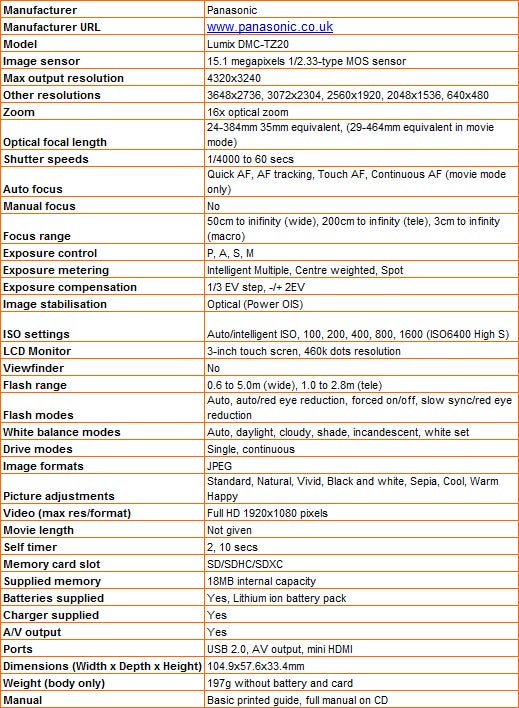
”’As with Panasonic cameras, the Lumix DMC-TZ20 offers Auto ISO and ‘intelligent’ ISO for those who want to leave the camera to decide, and with commendable consistency. Here the camera opted for the same ISO200 in each case. Otherwise, like its FT3 sibling, manually selectable light sensitivity settings are fairly standard, running from ISO100 up to a modest ISO1600, with the top ISO6400 option only available the camera itself deems it necessary via High Sensitivity mode.”’
—-

—-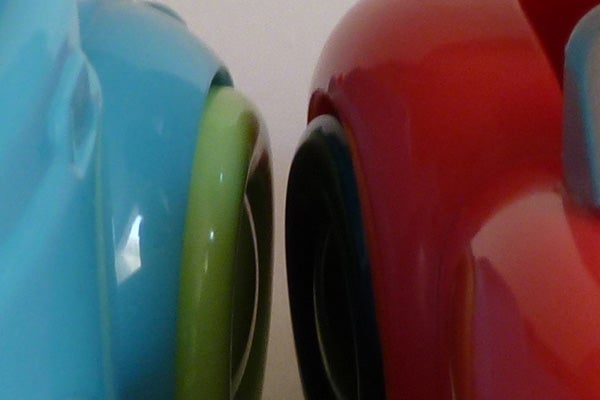
As expected at the lowest ISO100 setting as expected we’re not seeing any noise, though the preponderance of the colour red in the scene has leant our white background a pink-ish cast. Left to its own devices, the camera’s AF has also automatically focused on whatever is dead centre of frame; here the back wheels of our toy cars.
—-
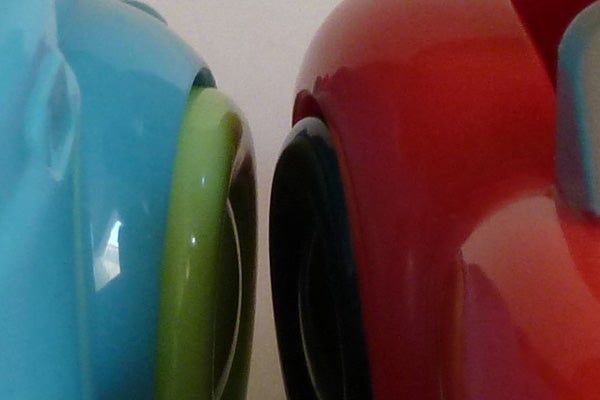
No discernible difference as we up the ante to ISO200, and similarly no image noise to report.
—-

At ISO400, normally the stage at which noise begins to intrude if we’re unlucky we are starting to get a higher proportion of grain in the shadow areas and a marginal softening of detail.
—-
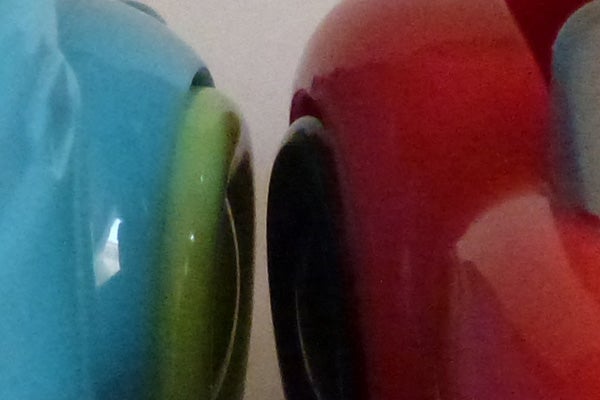
ISO800 and there’s noise spreading across the entire image if you look closely enough – and you don’t have to look too closely.
—-
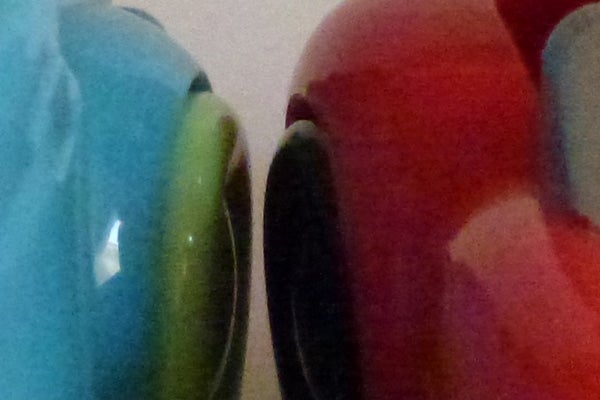
At ISO1600 noise is incrementally worse and more clearly defined, being sandy in texture.
—-

We’ve tried the High Sensitivity mode on our test subjects too, which results in a resolution drop in order to better disguise any increase in noise. OK, so grain has been smudged so isn’t as pronounced as it is at ISO1600, and the shot has a smoother look, but inevitably it’s at the expense of detail so we’d rather stick with ISO1600 (or preferably keep below ISO800) anyway.
—-
”’A more general selection of test shots are revealed on this page and next to act as an evaluation of the Panasonic Lumix DMC-TZ20 in a variety of shooting conditions.”’
—-

An image taken with the TZ20’s zoom at its widest, 24mm equivalent, setting. Good edge to edge sharpness with any barrel distortion well hidden amidst the natural setting, even if we are getting some obvious pixel fringing where tree branches meet sky at the upper corners of the frame. Also the image is a little flat straight out of the camera and could do with contrast being tweaked to give it a bit more visual oomph.
—-

The same is true in terms of lacking contrast at maximum 384mm equivalent telephoto setting, but comparing these two images should provide a very good idea of how close you can get (and from how far away) with the lens provided.
—-

An example of how well the lens copes about a foot away from its subject and with macro/close up mode selected. We get a sense of the texture of the stone (and the Victorian era grafitti!), which is nice, but again a little more edge definition would have been appreciated.
—-

And here’s an indication of the quality of JPEG delivered when shooting with the camera in 3D mode, which principally generates a MPO file, viewable only with a suitably 3D-equipped viewer. The JPEG is visibly low res and has the appearance of a video grab, so arguably really only of value as a reference tool.
—-
”’Here are some general test shots taken with the TZ20 to give an idea of performance ability when it comes to image quality, dynamic range, colour rendition and focal range.”’
—-

Another macro shot, this time taken in the golden light of a late afternoon. If anything the TZ20 has delivered a rather naturalistic colour display – the grass really was that verdant at the time, and in the mind’s eye at least the flowers appeared an even deeper shade of yellow in real life.
—-

If you leave the camera on iA (Intelligent Auto mode) for point and shoot operation it will reward you with images such as this – vivid colours delivered courtesy of the camera selecting landscape mode as the most apt setting for this particular scene. Good results with minimal fuss is the order of the day with the TZ20, and the same could really be said of the Lumix range in general.
—-

A telephoto shot from the same vantage point and we’re back to a more subdued, naturalist colour palette, and again, here we have an image that would benefit from a bit more contrast to really help that statue stand apart from the background.
—-

Another telephoto shot – this time at maximum zoom and of a subject everybody knows in the fading light of late afternoon. We’d have preferred a little more in the way of sharpness, but as a hand held capture from some distance away, the quality here isn’t bad at all.
—-
Trusted Score
Score in detail
-
Value 7
-
Image Quality 8
Features
| Camera type | Digital SLR, Digital Compact |
| Megapixels (Megapixel) | Megapixel |
| Optical Zoom (Times) | 12 Xx, 16 Xx |
| Image Sensor | CMOS |
| Image Stabilisation | Optical |
| LCD Monitor | 3 in |
| Flash modes | Auto Flash, Flash OFF, Flash ON, Red-eye Reduction, Slow Sync |
| Video (max res/format) | 640 x 480, 1920 x 1080 |

